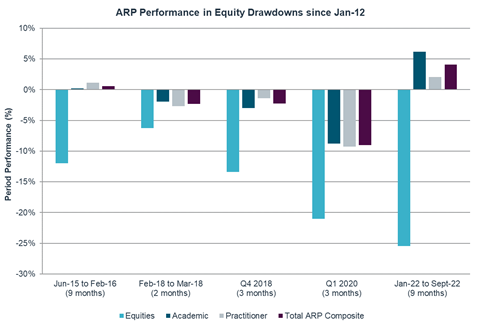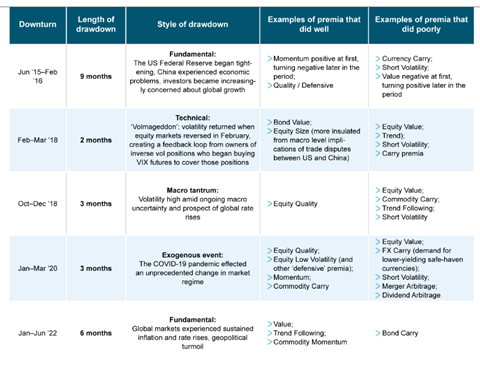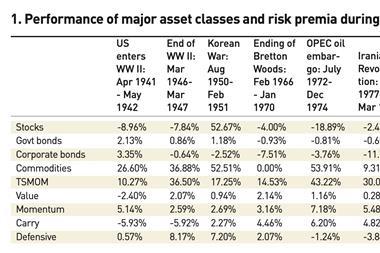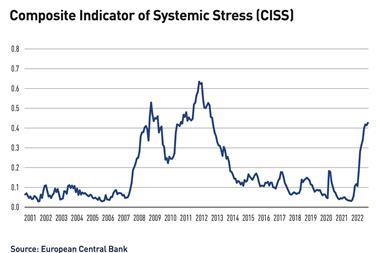While bond and equity markets have been pummeled in 2022, alternative risk premia strategies have at last been able to demonstrate their diversification prowess. Will this year’s performance restore investor confidence in these strategies after the painful results of 2020?
Alternative risk premia (ARP) strategies rose to prominence in the shadow of the global financial crisis. In 2012, barely a handful of funds were available to institutional investors; by 2018, that number was tipping 60. Their popularity was founded on the intersection of three powerful forces: investor demand for genuine diversification following the seismic pains of 2008, the growing academic validation for various ‘risk premia’ or ‘factors’ in the 2000s, and strong investor appetite for low- or lower-cost strategies.
The latter two forces also supported the rise of so-called ‘smart beta’ – ARP’s long-only cousin. While an expanding universe of smart beta strategies gave tilts to preferred risk factors in a beta-heavy format, ARP proffered market-neutrality with a long-short construct.
Where smart beta strategies focused on a specific asset class (most commonly equities), ARP strategies offered four: equities, bonds, commodities and currencies. A large minority of ARP managers even went beyond academic risk premia and added systematic versions of trading strategies that are well-established in the hedge fund community, such as risk arbitrage: these are sometimes called ‘practitioner premia’.
Early ARP investors were broadly satisfied with the modest positive performance that the sector initially delivered. An extended equity bull run, based on loose money, placed plenty of alternative investments (that were not themselves heavily exposed to equity risk) in the shade, but ARP was never positioned to compete with surging equity markets and could be accessed at relatively low cost.

Yet cracks in the performance record (and positive sentiment) became evident in 2018-19, before 2020 delivered a major blow: ARP strategies lost more than 8% in first quarter of that year and then failed to regain lost ground when equity markets rebounded from the pandemic slump.
Fund closures followed and have continued this year. In total, around 30% of all ARP strategies that were open in January 2020 are no longer available, while a further 10% have evolved into more alpha-focused systematic macro or quantitative multi-strategy funds and quietly dropped the ARP moniker.
Performance during downturns is of major reputational importance for alternative investments. Products that promise long-term diversification are not specifically intended to perform well during bear markets (that is the job of ‘divergent’ strategies), but diversifiers that do badly during crises – relative to expectations – tend to be met with a harsh gaze.
Not all downturns are created equal, however. Enter the 2022 crash: the first large, protracted, fundamentally-driven drawdown in equity markets since the ARP sector truly emerged.
In the absence of a COVID-style bounceback and/or positive returns in fixed income, alternative diversifiers have been particularly valuable in investors’ portfolios. Our data indicates that ARP strategies have delivered average returns of 4% net of fees between January and September, while the MSCI World has lost more than 25%.
If we focus purely on ‘academic’ ARP strategies, which only use academic risk factors, the strategy has returned around 6% in this period – a level roughly commensurate with many ARP managers’ return targets (cash plus 4-6% per year).


Source: bfinance, MSCI, Bloomberg. In the chart: ‘Equities’ indicates MSCI World (USD) index; ‘Total ARP Composite’ is an equally weighted composite of all ARP strategies whose performance is tracked by bfinance (net of fees); ‘Academic’ refers to Academic ARP strategies; ‘Practitioner’ refers to Practitioner ARP strategies (include systematised versions of some hedge fund trading strategies). Note: it can be challenging to draw simplistic conclusions on which premia did well/poorly, given the different ways of defining and constructing these premia (and the resulting performance differences). The table provides an approximate indication for narrative purposes.
In total, ARP strategies have outperformed equities during the five significant (>5%) drawdowns that the MSCI World has endured since 2012 and delivered positive absolute performance (on average) in two of them. It is crucial to understand the differences between these downturns and the underlying reasons why ARP strategies have responded differently.

One somewhat oversimplified takeaway, for example, is that ARP strategies appear to favour sustained drawdown periods, as opposed to shorter, sharper market dips. Another (somewhat related) observation is that ARP strategies have benefited from ‘fundamental’ downturns and struggled during the negative periods that were driven by technical or exogenous factors.
Diversification demand
Will the strong results during the 2022 downturn lead to a resurgence in investor demand for ARP? The signs, so far, are unclear: we have not yet witnessed a statistically meaningful shift in investor activity. Yet a positive shift in sentiment appears highly likely. As investors digest their performance through this year’s difficulties and determine how their portfolios should be positioned in a challenging macroeconomic climate, ARP strategies do still deserve attention.


















No comments yet